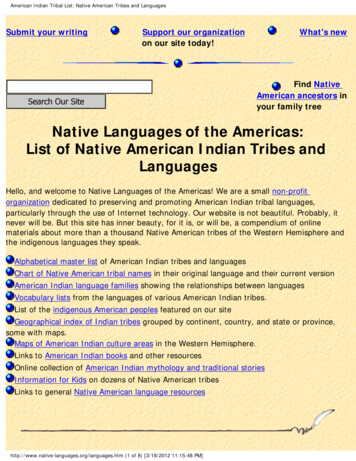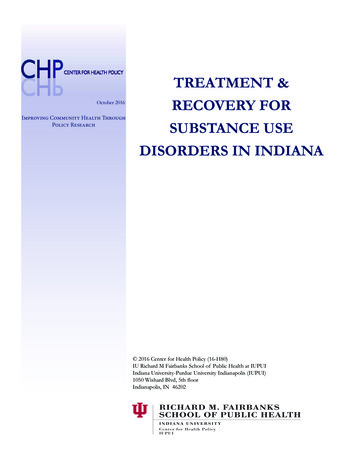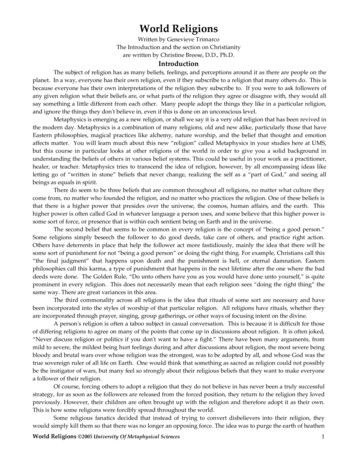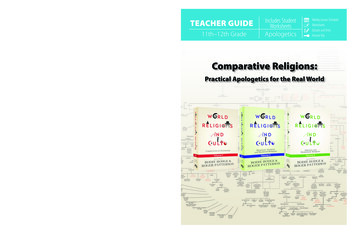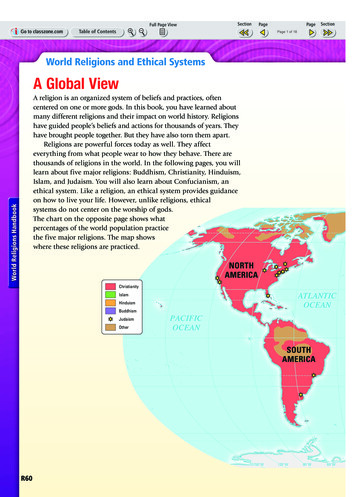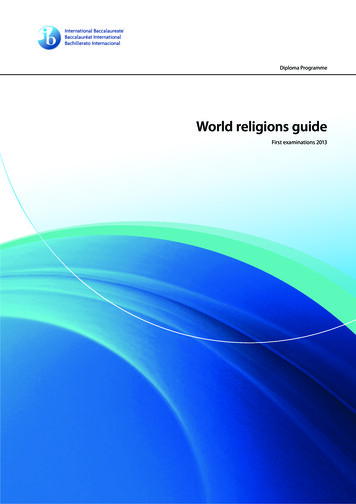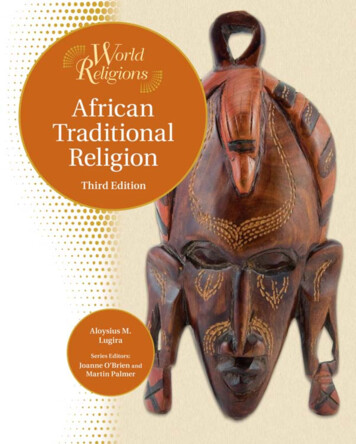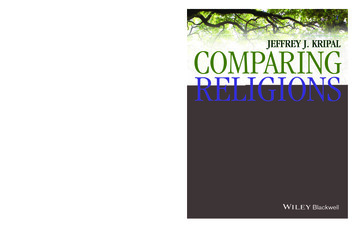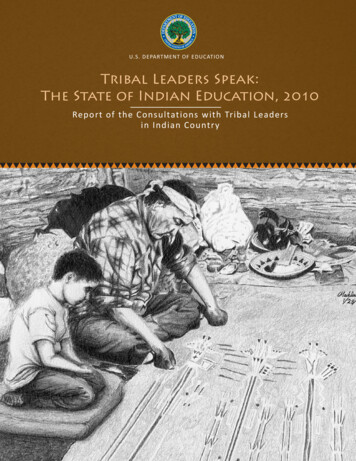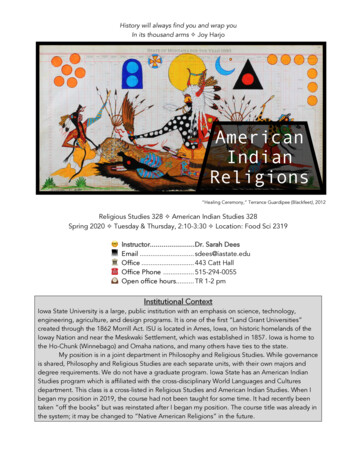
Transcription
History will always find you and wrap youIn its thousand arms Joy HarjoAmericanIndianReligions“Healing Ceremony,” Terrance Guardipee (Blackfeet), 2012Religious Studies 328 American Indian Studies 328Spring 2020 Tuesday & Thursday, 2:10-3:30 Location: Food Sci 2319 Instructor. Dr. Sarah DeesEmail . sdees@iastate.eduOffice . 443 Catt HallOffice Phone . 515-294-0055Open office hours. TR 1-2 pmInstitutional ContextIowa State University is a large, public institution with an emphasis on science, technology,engineering, agriculture, and design programs. It is one of the first “Land Grant Universities”created through the 1862 Morrill Act. ISU is located in Ames, Iowa, on historic homelands of theIoway Nation and near the Meskwaki Settlement, which was established in 1857. Iowa is home tothe Ho-Chunk (Winnebago) and Omaha nations, and many others have ties to the state.My position is in a joint department in Philosophy and Religious Studies. While governanceis shared, Philosophy and Religious Studies are each separate units, with their own majors anddegree requirements. We do not have a graduate program. Iowa State has an American IndianStudies program which is affiliated with the cross-disciplinary World Languages and Culturesdepartment. This class is a cross-listed in Religious Studies and American Indian Studies. When Ibegan my position in 2019, the course had not been taught for some time. It had recently beentaken “off the books” but was reinstated after I began my position. The course title was already inthe system; it may be changed to “Native American Religions” in the future.
Dr. Sarah Dees Spring 2020 RAAC Syllabus Database.Pedagogical ContextThis class is designed to offer insight into Indigenous ways of knowing within a broader context ofAmerican religious history. Due to my institutional context, this is the single Native Americanreligions class offered. A challenge in teaching the course is that, often, non-Native students (themajority of my students) have little academic/historical knowledge about Native religions, but theymay have been exposed to stereotypical ideas or assumptions about them through popularmedia. Part of the course, then, requires unlearning as well as learning. Furthermore, most nonNative students are unfamiliar with Native American issues within the broader U.S. history. Thishistory is crucial to understanding historical and contemporary Native religions. And in addition tothat history, it’s important that students understand diverse contemporary practices andperspectives from Native individuals and communities. As this may be the only class my studentsmay take on any aspect of Native American history/culture, it is important that the course coverskey features of Native American and Indigenous Studies. To account for these needs, I havedesigned the course to balance history with contemporary practices and perspectives. Similarly, Iseek to balance Native American and Indigenous Studies methods and theories with those fromReligious Studies. (My Oxford Research Encyclopedia essay on Native American Religions [DOI:10.1093/acrefore/9780199340378.013.404] provides a general overview of topics and issues Iseek to incorporate into the class. It also has suggestions for further reading.)The course begins with discussions on RS and NAIS method and theory. Extremeexamples from RS might suggest that community members’ perspectives don’t matter in theacademic study of religion, while extreme NAIS perspectives might suggest that only communitymembers’ perspectives are valid. The first unit in the class offers students a chance to bring theseperspectives into conversation, holding them in tension and exploring ethical ways to approachthis topic. The next part of the class (anchored by Niezen’s book) moves on to a history of U.S.settler colonialism and its effects on Native religions. We then turn to contemporary Nativepractices, exploring the theory of religious “reprise” that Dennis Kelley offers in his text. Throughthese units, we consider concepts and categories such as land/place, story, ritual, andsovereignty. Finally, we examine a text by a Native author that ties together many of these ideasand concepts. In previous iterations of the class, I’ve assigned Leslie Marmon Silko’s novelCeremony; this time around, I’ve assigned Braiding Sweetgrass by the Potawatomie biologistRobin Wall Kimmerer. (Other books could be switched out for this last text; students couldactually also read different texts.) The last part of the class is reserved for presentations. Mostassignments are scaffolded steps toward these final research projects, which I advise them on.For the first iteration of this course at Iowa State, students in a number of majors enrolled.Some of these students—including Religious Studies majors, American Indian Studies majors, andstudents majoring in program offered by World Languages and Cultures—had relevantbackground training. Some students were engineering or design majors with minimal backgroundexperience. One potential issue with this course design is that Native students and/or studentswith more of a background in this topic may find that parts of the class are too rudimentary. Forthose students, there is an opportunity to provide additional material so they may more quicklydive into specialized topics and advanced readings. But, for the majority of my students, this classequips them with important knowledge and perspectives to which they may otherwise not havebeen exposed.
Dr. Sarah Dees Spring 2020 RAAC Syllabus DatabaseCourse OverviewThe purpose of this course is to teach students about histories, sources, ways of knowing,politics, and ethical considerations that are valuable when seeking to understand NativeAmerican religious traditions. The course explores historical and contemporary Nativetraditions in what is today the United States. We will draw on theories from Religious Studiesand Indigenous Studies, and utilize a range of methods, including historical, anthropological,and cultural studies approaches. Lectures, readings, discussions, and assignments will help toilluminate features of Native American traditions and situate them within important historicaland political contexts. The course covers Native North American religious diversity, history,and contemporary practices. We will consider a number of issues: ethics, politics, practice,popular culture, self-determination, cultural appropriation, land rights, relationality, andenvironmentalism. We will both try to gain a big-picture look at themes and issues that affectmany practitioners while examining case studies from specific Native nations.Learning OutcomesBy the end of the term, students who have completed the course requirements will be able to: Understand Indigenous religious diversity in what is today North America (w/ focus on U.S.) Identify key themes and features useful for understanding Native American religious traditions Consider changes in Native American religious practices in response to European contact, theexpansion of the United States/U.S. empire, and globalization Critically assess methods used to study and understand Native religions, including the impactthese methods have on communities being studied Analyze contemporary issues that are pertinent to practitioners of Native American religioustraditions, including the ways that historical events have led to current issues Explain the relationship between Indigenous religions, spirituality, sovereignty, and selfdetermination Understand Indigenous theories and methods and Traditional Indigenous Knowledge Articulate—in written and spoken form—a unique response to the discourse on NativeAmerican religions by completing a research project that draws on Indigenous knowledgeRequired BooksKelley, Dennis (Chumash). Tradition, Performance, and Religion in Native America: AncestralWays, Modern Selves. New York: Routledge, 2015.Kimmerer, Robin Wall (Potawatomie). Braiding Sweetgrass: Indigenous Wisdom, ScientificKnowledge, and the Teachings of Plants. Minneapolis: Milkweed Editions, 2013.Niezen, Ronald (with contributions by Indigenous community members). Spirit Wars: NativeNorth American Religions in an Age of Nation Building. Berkeley: University of CaliforniaPress, 2000.
Dr. Sarah Dees Spring 2020 RAAC Syllabus DatabaseRequired Articles & Book Chapters (available on Canvas)Avalos, Natalie (Apache/Chicana). “Interview with Inés Talamantez.” Journal of FeministStudies in Religion 32.1 (2016): 153-168.Drawson, Alexandra, Elaine Tombs and Christopher Mushquash (Ojibway). “IndigenousResearch Methods: A Systematic Review.” The International Indigenous Policy Journal 8.2 (125).Hernández Ávila, Inés (Nez Perce/Tejana). “Mediations of the Spirit: Native American ReligiousTraditions and the Ethics of Representation.” In Native American Spirituality: A Critical Reader,edited by Lee Irwin, 11-36. Lincoln: University of Nebraska Press, 2000.Hoover, Elizabeth (Micmac/Mohawk). “Environmental Reproductive Justice: Intersections in anAmerican Indian Community Impacted by Environmental Contamination.” EnvironmentalSociology 4.1 (2018): 8-21.Lincoln, Bruce. “Theses on Method.” Method & Theory in the Study of Religion 8 (1996): 25-7.McNally, Michael. “Native American Religious Freedom Beyond the First Amendment.” InAfter Pluralism: Reimagining Religious Engagement, edited by Courtney Bender and PamelaKlassen, 225-51. New York: Columbia University Press, 2010.Tuck, Eve (Unagax/Aleut) and K. Wayne Yang, “Decolonization is not a Metaphor.”Decolonization: Indigeneity, Education, & Society 1.1 (2012): 1-40.Recommended ResourcesScholarly JournalsNative American & Indigenous StudiesAmerican Indian Culture & Research JournalAmerican Indian Law ReviewAmerican Indian QuarterlyDecolonizationNAIS JournalStudies in American Indian LiteraturesWicazo SaReligious StudiesJournal of the American Academy of ReligionJournal of Feminist Studies in ReligionJournal for the Scientific Study of ReligionMethod and Theory in the Study of ReligionNumenReligion and American CultureReligious StudiesMedia & Digital SourcesNative American & Indigenous StudiesAll My Relations podcastIlluminatives.orgIndian Country Today Media wsOnline.netReligious StudiesThe Immanent FrameKeeping it 101 podcastOn BeliefReligion DispatchesReligionNews.comThe Revealer
Dr. Sarah Dees Spring 2020 RAAC Syllabus DatabaseAssignmentsParticipationThis is a seminar-style class. The class format will include lectures and instructor-led discussions aswell as student-led discussions. As an upper-level, seminar-style course, student engagement anddiscussion are critical for the success of class periods. Students are expected to read the assignedreadings and come to class prepared to discuss them. Participation and engagement will begraded. Assignments include a geography quiz, media report, and discussion leadership.QuizThis will cover the traditional homelands of Native nations.Discussion LeadershipEach student will co-lead a discussion during the semester. Discussion leaders should prepare anoverview of some of the main issues or points that they want to highlight, questions for the classto discuss, and bring in an additional piece of insight that connects to the reading.Media ReportAt one point in the semester, each student will provide a brief overview of an issue related toNative traditions that they encounter in the news. Students will sign up for a day to present.Final ProjectThe final assessment will be a research project, either a traditional essay or a creative “unessay”(digital humanities project, website, creative writing or similar project of students choosing) that isgrounded in scholarship and includes a written reflection. Students will submit topic ideas beforeengaging in research, as well as graded assignments leading up to the final project (annotatedbibliography, introduction & outline) that will provide feedback and help them fine-tune theirprojects.AssignmentParticipationDiscussion LeadershipMedia ReportQuizFinal projectTopicAnnotated bibIntro & outlinePresentationFinal projectTotal )(5%)(55%)(10%)(10%)(5%)(30%)Due DateJan 30Feb 13 (in class)Feb 27March 12 (22 if you need spring break)April 14/16/21/23/28/30May 5
Dr. Sarah Dees Spring 2020 RAAC Syllabus DatabaseCourse Outline Readings due in class on the day listed. Bring a copy of assigned reading to class.Unit 1: Approaching the Study of Native American ReligionsWeek 1Tue., Jan. 14Course IntroductionLincoln (1996), “Theses on Method”Thu., Jan. 16Drawson et al. (2017) “Indigenous Research Methods”Week 2Tue., Jan. 21Avalos and Talamántez (2016), interviewThu., Jan. 23Hernández-Ávila (2000), “Mediations of the Spirit”Unit 2: Native Religious Traditions and U.S. EmpireWeek 3Tue., Jan. 28MissionizationNiezen, Chapter I, “Introduction”Niezen, Chapter 2 “The Conquest of Souls”Kim Burgess, “The Pequots’ Conversion to ChristianityThu., Jan. 30Boarding SchoolsNiezen, Chapter 3, “Learning to Forget”Manley Begay, Jr., “The Way of the Diné Still Sustains Us”QuizWeek 4Tue., Feb. 4Medical ImperialismNiezen, Chapter 4, “Medical Evangelism”Phyllis Fast, “Hearing Voices: Gwich’in AthabaskanPerceptions of Spirit Invasion and Recovery”Thu., Feb. 6Repression of Religious TraditionsNiezen, Chapter 5, “The Politics of Repression”Valerie Long Lambert, “Native Spiritual Traditions and theTribal State”Week 5Tue., Feb. 11Scientific ImperialismNiezen, Chapter 6, “The Collectors”Michael Wilcox, “Dialogue or Diatribe? Indians andArchaeologists in the Post-NAGPRA era”Thu., Feb. 13Cultural AppropriationNiezen, Chapter 7, “Apostles of the New AgeBernard Perley, “Medicine Wheelers and Dealers”Niezen, Chapter 8, “Conclusion”Topic Ideas DUE in classUnit 3: Modern Native North American Religious PracticesWeek 6Tue., Feb. 18Religious RepriseKelley, “A Brief Introduction”Kelley, Chapter 1, “Revitalization, Renewal, and Reprise:On the Modern Expressions of American Indian SpiritualCulture”
Dr. Sarah Dees Spring 2020 RAAC Syllabus DatabaseThu., Feb. 20Intertribal TraditionsKelley, Chapter 2, “Tradition, Modernity, and Spirituality:The Intertribal Powwow, Traditional Arts, & Lang Revival”Week 7Tue., Feb. 25Spirituality & ActivismKelley, Chapter 3, “Political Activism as Ceremony:Experiencing the Sacred Through Protest”Thu., Feb. 27Religion & HealingKelley, Chapter 4, “Traditional Identity and CommunalHealth: Religion and Well-Being in Indian Country”Annotated Bibliographies DUE 11:59 pmWeek 8Tue., Mar. 3Urban Native SpiritualityKelley, Chapter 5, “Jesus as the “Ultimate Sun Dancer: OnBeing Native and Christian in the City”Thu., Mar. 5Indigenous FuturitiesKelley, Chapter 6, “Into a Possible Future: An Epilogue”Week 9Tue., Mar. 10Native American Religious FreedomMcNally, “Native American Religious Freedom Beyond theFirst Amendment”Thu., Mar. 12DecolonizationTuck and Yang (2012), “Decolonization is not a Metaphor”Introduction & Outline DUE 11:59 pm SPRING BREAK Tue., Mar. 17 & Thu., March 19Spiritual Ecologies & Indigenous KnowledgeWeek 10Tue., Mar. 24Hoover, Preface and Introduction to The River is in Us:Fighting Toxics in a Mohawk CommunityThu., Mar. 26Kimmerer, PrefaceKimmerer, “Planting Sweetgrass”Week 11Tue., Mar. 31Kimmerer, “Tending Sweetgrass”Thu., Apr. 2Kimmerer, “Picking Sweetgrass”Week 12Tue., Apr. 7Kimmerer, “Braiding Sweetgrass”Thu., Apr. 9Kimmerer, “Burning Sweetgrass”Kimmerer, EpiloguePresentationsWeek 13Tue., Apr. 14Student PresentationsThu., Apr. 16Student PresentationsWeek 14Tue., Apr. 21Student PresentationsThu., Apr. 23Student PresentationsWeek 15Tue., Apr. 28Student PresentationsThu., Apr. 30Student PresentationsWeek 16Tues, May 5 @2:15 pmFinal Projects Due
Dr. Sarah Dees Spring 2020 RAAC Syllabus DatabaseClass PoliciesTransparency, Accessibility, & Educational SupportMy intention is to make this course accessible for all students, and my goal is to clearly state myexpectations so that every student understands what they need to accomplish in order tosucceed. If you have questions or encounter any issues with aspects of the course, please get intouch with me. I recommend both sending me an email (for documentation) and meeting inperson. I am available during my weekly open office hours and by appointment. There are manyresources on campus that can help you succeed in this course (see below).Additions to SyllabusStudents are responsible for all information presented in class, contained in the syllabus and oncourse site, and sent via email. The instructor reserves the right to modify the syllabus as needed,and may add pertinent information about assignments and policies to the course site.Collaborative Learning & Academic HonestyLearning is an individual as well as a collaborative experience. I expect original work (your ownwork created specifically for this class) and expect students to follow the standards of intellectualintegrity. The written work you turn in must be your own, and your sources must be properlyattributed (see university’s policies on plagiarism and academic honesty, which can be found athttp://catalog.iastate.edu/academic conduct). However, I do encourage you to seek feedbackfrom classmates, friends, and Writing Center staff—after all, we write for an audience, and gainingfeedback is an important part of the revising process. The Writing and Media Center (WMC)“helps students become stronger, more confident communicators. The WMC is a welcoming andinclusive peer tutoring center where friendly Communication Consultants offer individualizedassistance to undergraduate and graduate students working on any form of written, oral, visual, orelectronic communication.” Learn more: https://www.wmc.dso.iastate.edu.Iowa State Official Policy on Plagiarism (from http://catalog.iastate.edu/academic conduct)“Unacknowledged use of the information, ideas, or phrasing of other writers is an offensecomparable with theft and fraud, and it is so recognized by the copyright and patent laws. Literaryoffenses of this kind are known as plagiarism. Plagiarism occurs when a person does not credit thesources from which they borrow ideas, whether these ideas are reproduced exactly orsummarized. The method of documentation will differ depending on whether the sources arewritten, oral, or visual. Ethically, communicators are responsible for providing accurate, detailedinformation about their sources. Practically, audiences need this information to comprehend andevaluate a message's content.”Attendance and Participation PolicyThe success of the course depends on student preparation and participation. The Attendance andParticipation Policy reflects the significance of the learning that takes place in the collaborativeclassroom environment. Important lectures, activities, and/or discussions occur during each classperiod; if you miss class, you will miss something important. Regular, active class participation
Dr. Sarah Dees Spring 2020 RAAC Syllabus Databasegenerally correlates with higher scores on assignments. In addition, a student’s active participationin classes and group discussions benefits their student colleagues and the class as a whole.Because of the value this course places on collaborative learning, a portion of the final coursegrade will be determined by student participation in class discussions; the instructor reserves theright to further adjust the final grade to reflect student attendance and participation.1. Attendance. Students must sign the sign-in sheet during each class session. I will allow twomissed classes, no questions asked; beyond that, I will consider attendance when factoring theAttendance & Participation grade (or, in the amount of excessive absences, from the coursegrade). Students who miss class for any reason—excused or unexcused—will still be heldaccountable for class content, assignments, and group work. Disruptive tardiness or earlydeparture from class may result in a recorded absence.2. Excused absences. For an absence to be recorded as “excused,” it must be due to adocumented personal or medical emergency or university-related event. Within a week of theabsence, the student must upload a single .pdf document that includes:a. A coversheet, available online.b. A short paragraph summarizing of any reading that was assigned for the day (or thepreviously assigned reading). The summary should include the main idea of thereading and how the main idea is supported with examples. This should be copied intothe coversheet.c. Documentation from an official figure confirming the reason for the absence (whenpossible).d. Class notes acquired from a classmate who was present, either typed or scanned.e. If a student experiences a situation that will cause him/her to miss class for anextended period of time, s/he should speak with the instructor about the feasibility ofmaking up work and continuing with the class.3. Participation. Points are awarded at the end of the semester for active participation.a. Factors that may increase the participation grade:i. Thoughtful engagement with other students’ comments and questionsii. Demonstration of understanding of course materialsiii. Active participation in discussions and groupsb. Factors that may lower the participation grade:i. Use of technology in a way that distracts self or others from the classroomexperienceii. Lack of engagement with readings or discussion4. Technology in the classroom. You may use technology to access readings, write notes, or forpurposes related to the current class activity/discussion. Please do not distract yourself orothers by using technology for non-class-related purposes. If you are distracted by anotherstudent’s use of technology, please let me know.Assignment Submission Policy1. Assignment Submission.a. All assignments must be turned in through Canvas.b. Assignments will not be accepted via email or as hard copies.
Dr. Sarah Dees Spring 2020 RAAC Syllabus Databasec. Appropriate worksheets or coversheets must be used when submitting assignments.d. Assignments should be submitted as .doc., .docx, or .pdf files.e. All assignments will be automatically filtered through Turnitin plagiarism detectionsoftware.2. Technological Problems. For technological help, see the Canvas help guides or contact ISU’sSolution Center by phone (515-294-4000), email (solution@iastate.edu), ), or in person at Parks Library (Room # 192).Technical difficulties (problem with wireless internet, login difficulties, formatting, etc.) do notconstitute acceptable reasons for late work. It is recommended that students familiarizethemselves with Canvas and submit assignments well before the deadlines.3. Late work. One third of a letter grade may be deducted from an assignment per day it is late(e.g., a B would become a B- for an assignment that is turned in two days late).4. Make-up work. Major assignments and exams may only be re-scheduled in cases of personalor medical emergency. Major assignments and exams must be completed to receive a passinggrade in the course.5. Excused absence make-up. If you miss class for a legitimate reason, you may make up theabsence by following these steps:a. Download the excused absence worksheet on Canvas, where you will describe thereason for the absence and include a 150- to 250- word summary of each of theassigned readings.b. Combine the following items into a single .pdf document and submit it via Canvas:i. Worksheet describing the reason for the absence and a reading summaryii. Documentation of absence whenever possible (letter from a professor, medialnote, etc.)iii. Notes copied from a classmate who was present on the day you were absentPolicy on Email Communication with Instructor1. For email communication, please use your official university email account.2. In the subject line, please include the class number and time (e.g., Relig 210 9:00) as well as abrief indication of the subject of the email (e.g., Meeting to Discuss Paper).3. Grades cannot be discussed via email because of FERPA regulations.4. If you have a basic question about the class, please look over the syllabus and course site. Imay not respond to questions via email that the syllabus or course site could quickly clear up.5. I generally respond to emails from students during normal business hours, and will strive torespond quickly. If you have adhered to the email policy and have not received a timelyresponse, you’re is welcome to follow up or talk to me in class.6. For urgent issues, I would recommend both emailing me (for documentation) and meetingbefore/after class or during office hours to ensure the issue is resolved.7. I encourage you to follow the conventions of business communication in your emails. For abasic overview of college email etiquette, etiquette/netiquetteprofessor.html.
Dr. Sarah Dees Spring 2020 RAAC Syllabus DatabaseIowa State PoliciesAccessibility Statement & Student Accessibility Services(SAS)Iowa State University is committed to assuring that alleducational activities are free from discrimination andharassment based on disability status. Studentsrequesting accommodations for a documenteddisability are required to meet with staff in StudentAccessibility Services (SAS) to establish eligibility andlearn about related processes. Eligible students will beprovided with a Notification Letter for each course andreasonable accommodations will be arranged aftertimely delivery of the Notification Letter to theinstructor. Students are encouraged to deliverNotification Letters as early in the semester aspossible. SAS, a unit in the Dean of Students Office, islocated in room 1076, Student Services Building oronline at www.sas.dso.iastate.edu.Contact SAS by email at accessibility@iastate.edu or byphone at 515-294-7220 for additional information.Academic DishonestyThe class will follow Iowa State University’s policy onacademic dishonesty. Anyone suspected of academicdishonesty will be reported to the Dean of StudentsOffice.Dead WeekThis class follows the Iowa State University Dead Weekpolicy as noted in section 10.6.4 of the FacultyHandbook.Discrimination and HarassmentIowa State University does not discriminate on thebasis of race, color, age, ethnicity, religion, nationalorigin, pregnancy, sexual orientation, gender identity,genetic information, sex, marital status, disability, orstatus as a U.S. Veteran. Inquiries regarding nondiscrimination policies may be directed to Office ofEqual Opportunity, 3410 Beardshear Hall, 515 MorrillRoad, Ames, Iowa 50011, Tel. 515-294-7612, Hotline515-294-1222, email eooffice@iastate.eduReligious AccommodationIowa State University welcomes diversity of religiousbeliefs and practices, recognizing the contributionsdiffering experiences and viewpoints can bring to thecommunity. There may be times when an academicrequirement conflicts with religious observances andpractices. If that happens, students may request thereasonable accommodation for religious practices. Inall cases, you must put your request in writing. Theinstructor will review the situation in an effort toprovide a reasonable accommodation when possible todo so without fundamentally altering a course. Forstudents, you should first discuss the conflict and yourrequested accommodation with your professor at theearliest possible time. You or your instructor may alsoseek assistance from the Dean of Students Office at515-294-1020 or the Office of Equal Opportunity at515-294-7612.Iowa State University Principles of CommunityRespectWe seek to foster an open-minded understandingamong individuals, organizations and groups. Wesupport this understanding through outreach,increasing opportunities for collaboration, formaleducation programs and strategies for resolvingdisagreement.PurposeWe are encouraged to be engaged in the universitycommunity. Thus, we strive to build a genuinecommunity that promotes the advancement ofknowledge, cooperation and leadership.CooperationWe recognize that the mission of the university isenhanced when we work together to achieve thegoals of the university. Therefore, we value eachmember of the Iowa State University community fortheir insights and efforts, collective and individual, toenhance the quality of campus life.Richness of diversityWe recognize and cherish the richness of diversity inour university experience. Furthermore, we strive toincrease the diversity of ideas, cultures andexperiences throughout the university community.Freedom from discriminationWe recognize that we must strive to overcomehistorical and divisive biases in our society. Therefore,we commit ourselves to create and maintain acommunity in which all students, staff, faculty andadministrators can work together in an atmospherefree from discrimination, and to respondappropriately to all acts of discrimination.Honest and respectful expression of ideasWe affirm the right to and the importance of a freeexchange of ideas at Iowa State University within thebounds of courtesy, sensitivity and respect. We worktogether to promote awareness of various ideasthrough education and constructive strategies toconsider and engage in honest disagreements
Dr. Sarah Dees Spring 2020 RAAC Syllabus DatabaseIowa State Campus ---more/campus-resourcesAcademic Success Center: Provides opportunities for students to develop skills that promotesuccess, practice leadership, and become self-directed learners through the delivery of centralized,high-quality academic support services.Career Exploration Program: Designed to help students choose or change majors, discover howcareers relate to majors, and apply to graduate/prof
Braiding Sweetgrass: Indigenous Wisdom, Scientific Knowledge, and the Teachings of Plants. Minneapolis: Milkweed Editions, 2013. Niezen, Ronald (with contributions by Indigenous community members). Spirit Wars: Native North American Religions in an Age of Nation Building. Berkeley: University of California Press, 2000.
